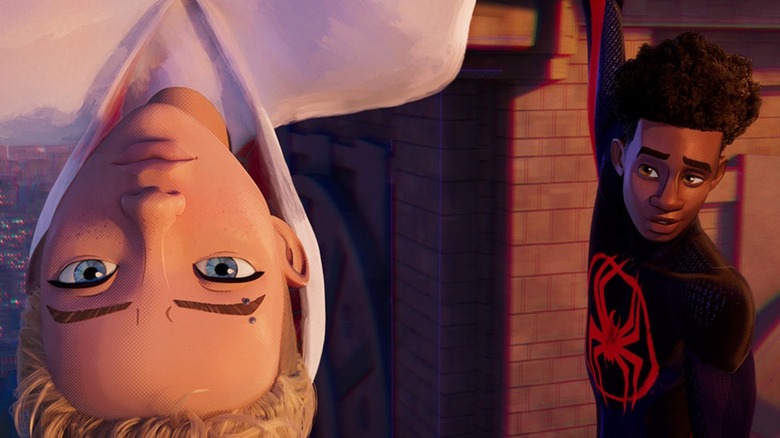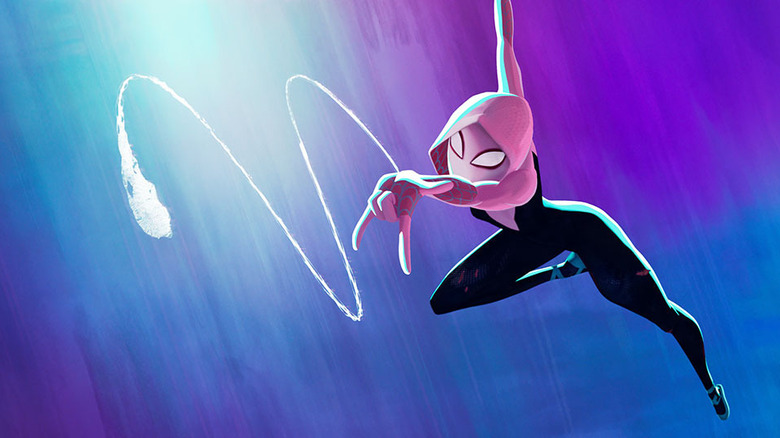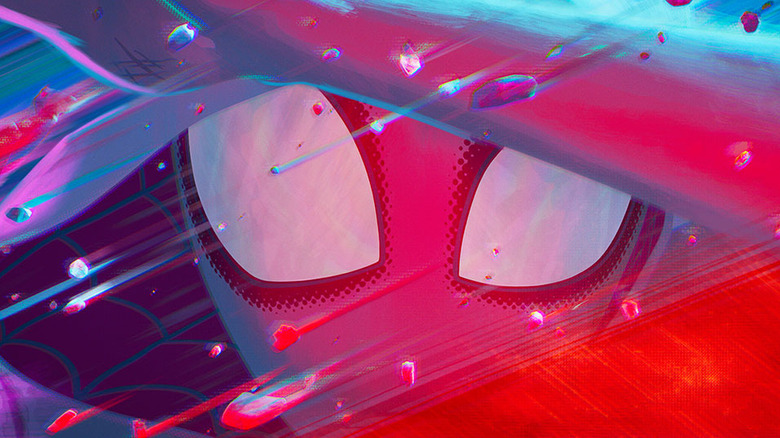Even Mundane Settings Are Gorgeous To Behold In Spider-Man: Across The Spider-Verse
One of the most astonishing things about "Spider-Man: Across the Spider-Verse" is that the filmmakers, through some sort of miraculous, creative happenstance, remembered that animation is an unlimited medium. There is a tendency among certain well-regarded animation studios (cough Disney cough), to push its animation style and character designs over to a very specific place. It's rare in, say, "Frozen," for scenes to dip into the abstract, or for characters to look genuinely striking and odd. In Disney films, especially the CGI animated ones, the characters tend to be like puppets. They can only squash and stretch so far, and they will never be off-model.
The characters in "Across the Spider-Verse" meanwhile, all seem to have emerged from their own private universes — which, by the premise's dictates, they did. There is a character who looks like a drawing out of Leonardo da Vinci's notebooks. Another seems to be physically constructed of punk rock band flyers. Some seem to be solid. Others flicker into abstract shapes when interdimensional apertures infect their bodies. Some are live-action, even. Throw all these characters into a fight scene, and reality breaks open, and the audience's eyes are flooded with shapes and colors the likes of which are rarely seen in mainstream animation.
But it's not just the swirling scenes of superhero mayhem and interdimensional travel that are dazzling. "Across the Spider-Verse" does slow down from time to time so that characters may quietly converse and take a rest from chases and fistfights. And even during these scenes, the colors and backgrounds are amazing to behold.
Spider-Gwen's world
One of the main characters in "Across the Spider-Verse" is Gwen Stacy (Hailee Steinfeld), the designated Spider-Person from her dimension. Like many of the other Spider-People, she keeps her superheroine identity hidden from her family, hoping that her police chief dad (Shea Whigham) won't ever find out. Her dad, of course, is suspicious of the mysterious Spider-Woman galavanting around New York, and dreams of arresting her one day. This is certainly not conducive to Gwen revealing herself.
Due to the circumstances of the film, however, Gwen will eventually have to remove her mask in front of her dad, causing intense familial strife. It will take most of the film before the two can confront each other and have a conversation about law enforcement and vigilante justice.
The scene where Gwen and her dad converse takes place in a New York apartment, and a plain one at that — this isn't an oversized New York apartment like on "Friends," but an average, a rather small domicile in a Brooklyn high-rise. The filmmakers, however — wanting to add stronger moods to the scene — allow the backgrounds to melt away and become a wash of watercolor-like vistas. One can still see the walls of the apartment through the colors, but it looks like the characters are surrounded by pink, purple, and blue tapestries. The walls change moods like a mood ring. As the emotional beats of the scene progress, the colors shift to match. The emotions are so large in "Across the Spider-Verse" that reality itself alters.
The beauty of the mundane
Earlier in the film, Gwen has a conversation with Miles Morales (Shameik Moore), a close friend and the Spider-Man from a neighboring dimension. They mutually lament their outsider status as Spider-People, bemoaning that they are unable to reveal their secret identities to their families. They also flirt a little bit, as Miles is clearly very attracted to Gwen. The scene, naturally, takes place on a quiet, remote rooftop that looks out onto a distant downtown Manhattan. While other movies might well have staged a similarly romantic scene on a rooftop, "Across the Spider-Verse" ups the ante by flipping everything upside down. Since both Gwen and Miles can stick to walls and ceilings with their Spider-Powers, there's no reason why they can't sit on the underside of a buttress and lean on each other.
The scene is calm and lovely but also offers a perspective on the world that only these characters can have. The world is upside down to them, and only to them. And they're comfortable with that. It's a typical romantic scene made beautiful by the mechanics of the Spider-Verse.
One might hope other animators are looking to "Across the Spider-Verse" and becoming inspired to up their game. Too many animated movies have perhaps become too enamored of realism to really stretch creatively, presenting unusual character designs or bonkers set pieces that can't exist in reality. The "Spider-Verse" films remind filmmakers that anything is possible, and adhering to the rules of gravity and physics is, at the end of the day, a mere obstruction. Abandon reality, and beauty can be discovered.


